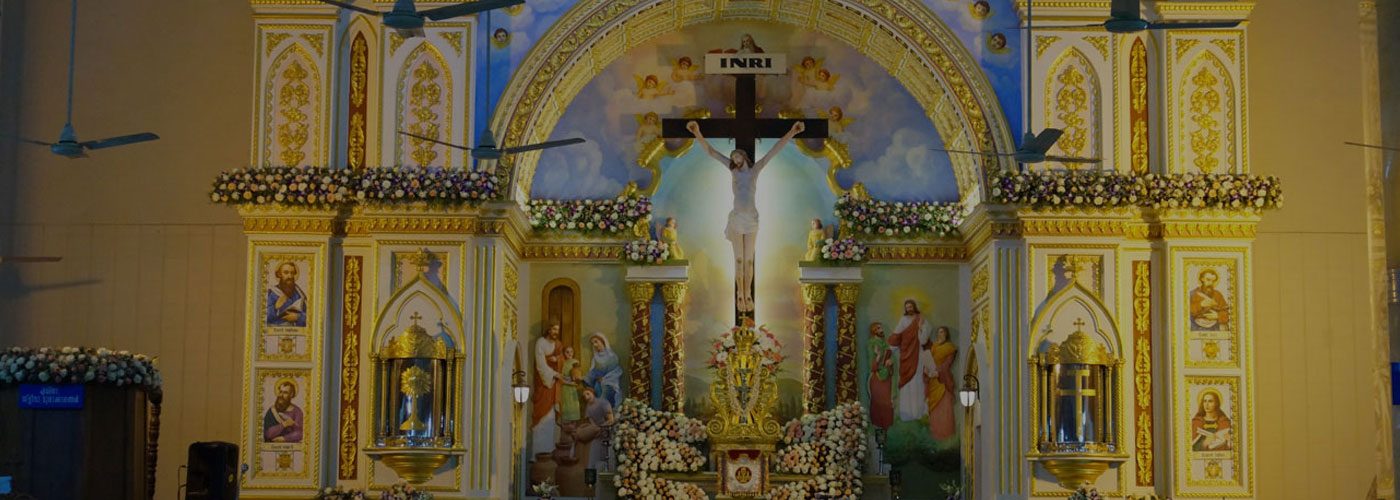- Home
- Legacy
Legacy



Positioned merely 20 kilometers from Azhikode, a place deeply linked to the dawn of Christianity in India, the Mapranam Holy Cross Shrine Church is an integral part of the Irinjalakuda diocese. This historical sanctuary stands as a revered pilgrimage site, strategically nestled in the captivating rural backdrop of Kerala. With roots stretching back to the year 928 A.D., it ranks among the oldest churches. A recent renovation in 1989 has transformed it into an attraction that draws worshipers transcending religious boundaries. Remarkably, this sanctum is a pioneering example, seamlessly harmonizing and embodying the cultural, spiritual, and ethical facets of diverse religions, including Christianity, Hinduism, and Islam.
Accepted and recognized by the masses across the region, the church holds a distinctive place, serving as a mother institution for nearly 100 churches affiliated with the Dioceses of Trichur Metropolitan and Irinjalakuda. Established over a millennium ago, it is seen as a monument that unveils the rich tapestry of history. The region was historically known as Mahabrahmanapuram, an area inhabited by Brahmins and adorned with Hindu temples. An interesting narrative attributes the origin of the name "Mapranam" to a defeated king seeking refuge, where locals halted him with the Sanskrit term "Ma-Prayanam," meaning "stop retreat." This evolved over time to "Mapranam." The locality was segmented with names like Kuzhikkattukon, Madayikon, Thaliyakon, and Peechampallykon, with "kon" signifying corners.
The church's origin stories vary, each resonating with its rich historical context. Some believe that a Cross was uncovered in the Kuhikkattukon area and placed there, followed by an inexplicable heavy rainstorm that occurred that night, causing the Cross to be found floating near the present-day Church Mapranam. Another narrative ties local rulers' involvement in territorial disputes and civil conflicts, where they engaged "Nasranis" (Christians) to confront challenges, leading to the church's construction. Trade is also associated with its origin, suggesting that a port named Konthipulam facilitated commerce and that the ruling king allocated land for the church in gratitude for Christian trade in the region. The influence of Tippu Sulthan, a renowned ruler, also features in the legends, where his interaction with an outcaste Namboothiri led to the church's preservation.
In 1989, during the church's renovation, more evidence of its historical past was uncovered. Remarkably, the church's construction utilized teak wood, while the Cross placed in the Sanctum was made of Jack Wood, revealing its close ties to Hindu beliefs and customs of that era. Historical records show that Annual Festivals dedicated to the Holy Cross were celebrated as far back as 335 A.D. The Cross within the church, built under Persian influence, stands as a testament to the dominance of the Kaldaya sect, raising the possibility of Nasranis' involvement in the church's construction in the 4th or 5th Century.
Portuguese chronicles dating 300 years back highlight the church's importance under the name "Mahapookkonam." Revenue records refer to it as the "Aloor Church" in the "Moudayikon" village. The church's unique distinction as the only one named "Holy Cross" in the dioceses of Irinjalakuda, Thrissur, and Palakkad further elevates its historical standing within the Syro-Malabar Archi Episcopal Church. Recognized by Varapuzha Malabar Centre Archi Episcopal Apostholic Vicar Rev. Fr. Mar. Selesus Aasghanda Teresa, the church received approval to house the Holy Relics. These relics, acquired from the Vatican in 1888, embody the Holy Blood of Jesus Christ from the shroud of St. Veronica and the heart of Jesus Christ, pierced by a lance. These three Holy Relics, housed with authentic certificates from the Pope, set the Mapranam Holy Cross Church apart as the sole Indian church with such significant assets.
The Holy Cross Church of Mapranam transcends its historical significance by embodying religious harmony and unity. Its architecture and façade promote integrity and oneness, sending a profound message of religious coexistence and secularism. At a time when religious harmony is scarce, the church stands as a powerful example of unity and understanding.
Extending from Kanyakumari to Chandragiripuzha, ancient Kerala was dotted with small kingdoms and rulers. Mahabrahmanapuram was one such territory. The establishment of the Thrissur Vicariate in 1887 by Pope Leo XIII marked a significant moment. Previously, Marthoma Christians were under the Varapuzha Apostolic Vicariate. The earliest Vaidiga Panchangam, published by the Thrissur Vicariate, dates the establishment of Mapranam Mar Sleeva Church to 928. Over the centuries, the church has undergone multiple rebuilds to accommodate the growing Christian community. In 1988, construction of the present building commenced, revealing signs of ancient churches during excavation.
The church's storied history is further supported by the discovery of a Kadakkannan terracotta piece with the inscription AD 928 in front of the demolished old church. The presence of twelve large earthen jars under the soil adds to its historical intrigue.
The central celebration at the Shrine revolves around the Exaltation of the Holy Cross. This festive occasion takes place from September 5 to 21 each year. The festivity commences on September 5 with the ceremonial raising of the flag. The pivotal days of the celebration unfold between September 12 and 15. On September 13, the Thirithelyikkal and Pushppakurisu (procession) are held. The climax of the festival, occurring on September 14, encompasses the significant 'festal' Holy Mass, the grand procession, the reverent veneration of Holy Relics, and a spectacular fireworks display. The commemoration of departed Parishioners takes place on September 15, with the Octave occurring on September 21.
The Church's origins trace back to the year 928 A.D., coinciding with the inception of the Thirithelikkal tradition (Candle Lighting). This enduring practice involves around 500 worshippers lighting candles ranging from 1 to 300 kg. It unfolds on September 13, the eve of the Church's primary feast, the Exaltation of the Cross, with an annual participation of approximately 300,000 devotees seeking blessings from the Holy Cross. Since the Church's establishment, beeswax candles have been employed for this purpose, complemented by various oils used for Thiritheliyikkal.
In 1986, this tradition took on remarkable dimensions when a non-Christian member illuminated a sizable 64 kg candle. The offerings made during this practice transcend religious boundaries, embodying stories of divine intervention. Notably, a mother's candle offering during a Gulf crisis to support her son and a believer's fervent plea for parenthood, symbolized by a 60 kg candle, stand out as miraculous instances. The latter individual was blessed with a child within a year, who recently reached the age of 20.
Worshippers kindle large candles corresponding to their own weight, the combined weight of couples, the weight of newborns, or the weight of family members. Visitors, particularly Bishops, Priests, Nuns, and Laymen who have traversed the globe to locations such as the Holy Land in Asia, Europe, Australia, and North & South America, attest that no similar grand candle lighting tradition exists anywhere else in the world, except within the precincts of Mapranam Church.
Regrettably, numerous precious historical artifacts such as the Alavattam, Venchamaram, and copper plate inscriptions have been lost to time. Likewise, the images that once adorned the rear wall of the Holy of Holies, showcasing the profound influence of Persian art, have faded away. Nevertheless, a few ancient treasures have been meticulously preserved. Among these is the remarkable Seelanthi, a massive wooden beam that stands as a testament to the past. Constructed from teak wood, this artifact boasts an age of at least 600 years.
Magnificent carvings adorn two sides of the Seelanthi, spanning a length of 25 feet and possessing a thickness of 1.75 x 1.5 feet. Remarkably, the surface has not been smoothed down to plainness, retaining the exquisite craftsmanship of Ulichetthu. Engravings on the Seelanthi depict a lion overpowering an elephant's mind, a dragon entwined with blossoming branches and vines, and a cluster of parrots relishing fruits. Yet, the vibrant hues that once colored these engravings, derived from natural leaf pigments, have gradually faded over time.
A fascinating legend envelops the Seelanthi. The daughter of a Kongini Brahmin had suffered from possession by an evil spirit. In her most desperate hour, the Brahmin turned to Kurisumuthappan, and his intervention led to her miraculous recovery. Coinciding with this moment, a towering jack tree within the church compound was uprooted. Overjoyed by his daughter's restoration but saddened by the fallen tree, the Brahmin presented high-quality teak wood to the church. This wood, transported by elephants, is believed to form the core of the revered Seelanthi, shaped in the likeness of a figure perched atop an elephant.
Today, the Seelanthi finds its place in the mondalam of the church, an area accessible to visitors for observation and admiration. Supported by two granite pillars sourced from the esteemed Kollengodu palace, the Seelanthi stands as a beacon of cultural heritage, a repository of spiritual insights from its time, skillfully etched into the teak wood's intricate carvings.
The pulpit, known as "pushpam," stands as a unique feature found in ancient churches. This distinctive element is mentioned in the 21st canon of the Udayamperoor Synod: "The sacred Synod has decided to build the pulpit (pulpam) to make the people hear the holy Word of the Lord in select churches." The venerable Mapranam Church, being one of the prominent establishments of its time, promptly embraced this decision. This artistic pulpit within the church takes the form of a dragon gracefully clasping a sea flower in its jaws. Positioned near the altar, it serves as the podium from which the Word of God is preached during services.
Within the church's hallowed halls, an array of precious records dating back 250 to 400 years finds safekeeping on palm leaves. These venerable documents contain a wealth of historical information, including significant records such as the theettooram (royal decree) of the Maharaja of Cochin. Among the treasures preserved are a towering three-foot-tall bronze bell, hailing from Italy and aged over 300 years, a radiant flower cross, sacred vestments, majestic crosses cast from pure silver, an intricately engraved sacrary, and a substantial teak wood chest designated for offerings of grains. These cherished possessions bear testimony to the church's eminence and its enduring legacy.
The church also holds a special place for people of diverse faiths, who come to make unique offerings such as nerchavedi, thulabharam, and adimayiruthal. The growing number of worshippers attests to the unwavering belief that Kurisumuthappan will heed the heartfelt prayers of all who seek solace and guidance.
The parish of Holy Cross Church Mapranam is demarcated by distinct boundaries:- To the South: The boundaries of Madayikonam and Irinjalakkuda Villages, a canal from Kandamkulathi compound to Muriyad Kayal, Kanjanikulam Road, Madayikonam School - Kuzhikattukonam Road, Valanchira.
- South-East: Kokkara Canal.
- East: Thommana Canal to Puthenthodu via Konthipulam Bridge.
- North: Paikkadam Junction, Chitravalli Bund, the Perunthode of Chithrapilly paddy field, a purampoke thodu to Chitravally, the Irinjalakuda -Thrissur Road, a new road to the western side from Irinjalakuda -Thrissur Road, the Coir Company Road, south side of the Panchayat Stadium, North West part leading to Chemmanda Kayal.
- West: Panolithode, Kallelypadam, Subash Nagar Road, and Pallikkad Road that lies South-West, the Canal through the compound of Kandamkulathy to Muriyad Kayal.
The Holy Cross Church stands as a remarkable symbol of religious harmony and unity, welcoming individuals from all walks of life. Its sanctum serves as a haven for spiritual growth. The parish fosters various associations like Religious Awareness Units, Family Units, C.L.C., St. Vincent De-Paul Society, Franciscan Almaya Sabha, Legion of Mary, Jesus Youth Boys, Jesus Youth Girls, Mothers Unit, Prayer Groups, Choir, Altar Boys, Social Action Unit, Social Welfare Centre, Unity Centers, Self Help Groups, and more. These associations extend their benevolent service not only to parishioners but also to the broader community in spiritual, cultural, educational, and economic spheres.

"Have I not commanded you? Be strong and courageous. Do not be terrified; do not be discouraged, for the Lord your God will be with you wherever you go."